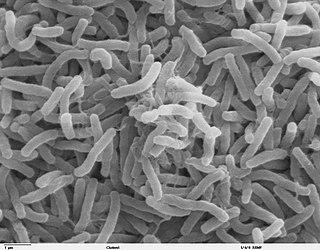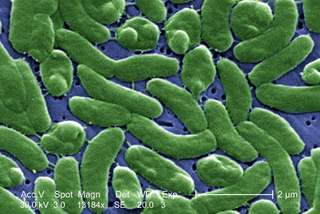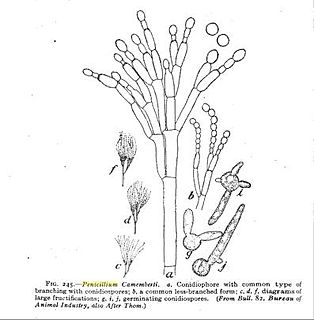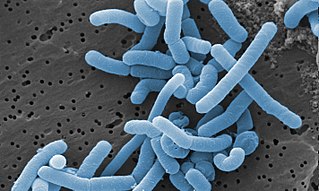
Vibrio cholerae is a species of Gram-negative, facultative anaerobe and comma-shaped bacteria. The bacteria naturally live in brackish or saltwater where they attach themselves easily to the chitin-containing shells of crabs, shrimps, and other shellfish. Some strains of V. cholerae are pathogenic to humans and cause a deadly disease cholera, which can be derived from the consumption of undercooked or raw marine life species.

Penicillium is a genus of ascomycetous fungi that is part of the mycobiome of many species and is of major importance in the natural environment, in food spoilage, and in food and drug production.
El Tor is a particular strain of the bacterium Vibrio cholerae, the causative agent of cholera. Also known as V. cholerae biotype eltor, it has been the dominant strain in the seventh global cholera pandemic. It is distinguished from the classic strain at a genetic level, although both are in the serogroup O1 and both contain Inaba, Ogawa and Hikojima serotypes. It is also distinguished from classic biotypes by the production of hemolysins.

Vibrio is a genus of Gram-negative bacteria, possessing a curved-rod (comma) shape, several species of which can cause foodborne infection, usually associated with eating undercooked seafood. Typically found in salt water, Vibrio species are facultative anaerobes that test positive for oxidase and do not form spores. All members of the genus are motile. They are able to have polar or lateral flagellum with or without sheaths. Vibrio species typically possess two chromosomes, which is unusual for bacteria. Each chromosome has a distinct and independent origin of replication, and are conserved together over time in the genus. Recent phylogenies have been constructed based on a suite of genes.

Vibrio vulnificus is a species of Gram-negative, motile, curved rod-shaped (bacillus), pathogenic bacteria of the genus Vibrio. Present in marine environments such as estuaries, brackish ponds, or coastal areas, V. vulnificus is related to V. cholerae, the causative agent of cholera. At least one strain of V. vulnificus is bioluminescent.

Vibrio parahaemolyticus is a curved, rod-shaped, Gram-negative bacterium found in the sea and in estuaries which, when ingested, causes gastrointestinal illness in humans. V. parahaemolyticus is oxidase positive, facultatively aerobic, and does not form spores. Like other members of the genus Vibrio, this species is motile, with a single, polar flagellum.

Lacticaseibacillus casei is a species of genus Lacticaseibacillus. This particular species of Lacticaseibacillus is documented to have a wide pH and temperature range, and complements the growth of L. acidophilus, a producer of the enzyme amylase.

Penicillium camemberti is a species of fungus in the genus Penicillium. It is used in the production of Camembert, Brie, Langres, Coulommiers, and Cambozola cheeses, on which colonies of P. camemberti form a hard, white crust. It is responsible for giving these cheeses their distinctive flavors. An allergy to the antibiotic penicillin does not necessarily imply an allergy to cheeses made using P. camemberti.

Lacticaseibacillus rhamnosus is a bacterium that originally was considered to be a subspecies of L. casei, but genetic research found it to be a separate species in the L. casei clade, which also includes L. paracasei and L. zeae. It is a short Gram-positive homofermentative facultative anaerobic non-spore-forming rod that often appears in chains. Some strains of L. rhamnosus bacteria are being used as probiotics, and are particularly useful in treating infections of the female urogenital tract, most particularly very difficult to treat cases of bacterial vaginosis. The species Lacticaseibacillus rhamnosus and Limosilactobacillus reuteri are commonly found in the healthy female genito-urinary tract and are helpful to regain control of dysbiotic bacterial overgrowth during an active infection. L. rhamnosus sometimes is used in dairy products such as fermented milk and as non-starter-lactic acid bacterium (NSLAB) in long-ripened cheese. While frequently considered a beneficial organism, L. rhamnosus may not be as beneficial to certain subsets of the population; in rare circumstances, especially those primarily involving weakened immune system or infants, it may cause endocarditis. Despite the rare infections caused by L. rhamnosus, the species is included in the list of bacterial species with qualified presumed safety (QPS) status of the European Food Safety Agency.

Geotrichum candidum is a fungus which is a member of the human microbiome, notably associated with skin, sputum and feces where it occurs in 25–30% of specimens. It is common in soil and has been isolated from soil collected around the world, in all continents.
Mother Noella Marcellino, O.S.B., is an American Benedictine nun who has earned a doctorate in microbiology from the University of Connecticut. Studying fungi in France on a Fulbright Scholarship, she concentrated on the positive effects of decay and putrefaction as well as the odors and flavors of cheese.

Hafnia is a genus of Gram-negative, facultatively anaerobic, rod-shaped bacteria in the family Hafniaceae.
Agrococcus is a genus in the phylum Actinobacteria (Bacteria).
Vibrio campbellii is a Gram-negative, curved rod-shaped, marine bacterium closely related to its sister species, Vibrio harveyi. It is an emerging pathogen in aquatic organisms.
Vibrio fluvialis is a water-borne bacterium first isolated from patients with severe diarrhoea in Bahrain in the 1970s by A. L. Furniss and his colleagues, and is considered to be an emerging pathogen with the potential to have a significant impact on public health. Upon discovery, this organism was considered to be similar to both Vibrio and Aeromonas species, but was ultimately determined to be more closely related to Vibrio. V. fluvialis can be found in salt waters globally and also has the potential to infect both humans and a variety of crustaceans.
Vibrio furnissii is a Gram-negative, rod-shaped bacterium. Its type strain is ATCC 35016. V. furnissii is aerogenic (gas-producing), and uses L-rhamnose, L-arginine, L-arabinose, maltose, and D-mannitol, but not L-lysine, L-ornithine, or lactose. It has been isolated from patients with gastroenteritis, bacteremia, skin lesions, and sepsis.

Lacticaseibacillus paracasei is a gram-positive, homofermentative species of lactic acid bacteria that are commonly used in dairy product fermentation and as probiotic cultures. Lc. paracasei is a bacterium that operates by commensalism. It is commonly found in many human habitats such as human intestinal tracts and mouths as well as sewages, silages, and previously mentioned dairy products. The name includes morphology, a rod-shaped bacterium with a width of 2.0 to 4.0μm and length of 0.8 to 1.0μm.
Bavariicoccus is a genus of bacteria of the phylum Firmicutes. This genus contains a single species, Bavariicoccus seileri, strains of which were originally isolated from German soft cheese. Bacterial taxonomists have suggested that Bavariicoccus may be more appropriately placed within the family Carnobacteriaceae.
Microbacterium barkeri is a bacterium from the genus of Microbacterium which has been isolated from domestic sewage and from smear from a cheeses. Microbacterium barkeri has the ability to degrade polyvinyl alcohol.










